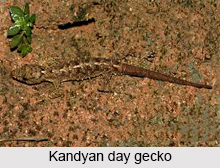 Kandyan Day Gecko or Kandyan Rock Gecko is an Indian Reptile found in the mountain ranges of India. It has the scientific name of "Cnemaspis kandiana".
Kandyan Day Gecko or Kandyan Rock Gecko is an Indian Reptile found in the mountain ranges of India. It has the scientific name of "Cnemaspis kandiana".
Concentration of Kandyan Day Gecko
Kandyan Day Gecko is a species of diurnal gecko found in Sri Lanka, southern India, Andaman Islands, Indonesia (Sumatra), and southern Thailand.
Structure of Kandyan Day Gecko
The head of Kandyan Day Gecko is rather elongated; the snout is obtusely pointed, longer than the distance between the eye and the ear opening, l.5 the diameter of the orbit; the forehead is not concave; the ear opening is small and oval. Its body and limbs are rather slender. The hind limbs reach the axilla or the shoulder.
Digits of Kandyan Day Gecko
The digits of Kandyan Day Gecko are slender. The basal part is not dilated, scarcely wider than the distal and with enlarged plates beneath.
Snout of Kandyan Day Gecko
The snout of Kandyan Day Gecko is covered with suboval keeled granules; the rest of the head is minutely granulate; the rostral is twice as broad as deep, with median emargination and cleft above. The nostrils are pierced between the rostral and three or four nasals; seven or eight upper and as many lower labials are found. The mental is large and triangular, with a truncated posterior angle; numerous small chin-shields pass gradually into the gular granules, which are feebly keeled.
Upper Surface of Kandyan Day Gecko
The upper surface of Kandyan Day Gecko is covered with small, more or less distinctly keeled granules, intermixed with irregularly scattered, small, keeled tubercles; the flanks are small and widely separated, with spine-like tubercles.
Scales of Kandyan Day Gecko
The scales on the limbs of Kandyan day gecko are keeled. The ventral scales are cycloid and imbricated. Those under the neck are keeled, and the others are smooth (or keeled in C. k. tropidogaster`). Males have three or four preanal pores, and on each side three to five femoral pores.
Tail of Kandyan Day Gecko
The tail of Kandyan Day Gecko is cylindrical, tapering, above with very small keeled scales and annuli of spine-like tubercles, beneath with larger scales, but no transversely dilated median plates.
Colour of Kandyan Day Gecko
Kandyan Day Gecko is brown in colour, variegated with darker and lighter. These variegations generally form transverse markings on the back and tail; sometimes, a light vertebral band occurs; the spine-like tubercles on the flanks are white; its lower surfaces are light brown or dirty white; the throat is sometimes blackish. From snout to vent, it is 1.4 in long and the tail is 1.5 inches.



















